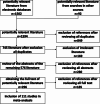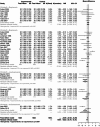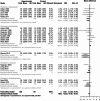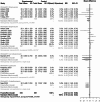Systematic review and meta-analysis of pain management after tonsillectomy
- PMID: 39789114
- PMCID: PMC11718165
- DOI: 10.1038/s41598-024-85008-5
Systematic review and meta-analysis of pain management after tonsillectomy
Abstract
Tonsillectomy is one of the most common operations. Tonsillectomy is also one of the most painful surgical procedures. However, there is still no satisfactory standard for postoperative pain management. Four databases (Cochrane Library, Ovid Technologies, PubMed, Web of Science) were searched for the period from 1908 to 2019. The systematic literature review followed the Preferred Reporting Items for Systematic Reviews and Meta-Analyses (PRISMA) guidelines. Data were pooled using random-effects and fixed-effects models. Randomized controlled trials, reviews and meta-analyses were included. Primary outcomes were quantitative pain intensity in the first 24 h after tonsillectomy and on days 1, 3, and 7 postoperatively. The search yielded 1594 publications, of which 111 publications with 7566 patients, both children and adults, could be included. Intraoperative medication with intravenous dexamethasone significantly reduced pain (mean difference [MD] -0.42; 95% confidence interval [CI]: -0.61- -0.24). Among the local anesthetics, only the preoperative injection of levobupivacaine into the tonsillar compartment was able to provide sufficient pain reduction up to three days after tonsillectomy (MD: -1.92; 95% CI: -2.73 - -1.11). Preoperative or intraoperative administration of non-steroidal anti-inflammatory drugs (NSAIDs) significantly reduced pain (MD: -0.75; 95% CI: -0.87- -0.63). Steroids and NSAIDs are an important part of pain management after tonsillectomy.
Keywords: Clinical trial; Meta-analysis; NSAID; Pain therapy; Tonsillectomy.
© 2025. The Author(s).
Conflict of interest statement
Declarations. Competing interests: The authors declare no competing interests.
Figures






















Similar articles
-
The effect of IV dexamethasone versus local anesthetic infiltration technique in postoperative nausea and vomiting after tonsillectomy in children: A randomized double-blind clinical trial.Int J Pediatr Otorhinolaryngol. 2017 Jan;92:21-26. doi: 10.1016/j.ijporl.2016.10.030. Epub 2016 Oct 28. Int J Pediatr Otorhinolaryngol. 2017. PMID: 28012528 Clinical Trial.
-
PROSPECT guideline for tonsillectomy: systematic review and procedure-specific postoperative pain management recommendations.Anaesthesia. 2021 Jul;76(7):947-961. doi: 10.1111/anae.15299. Epub 2020 Nov 17. Anaesthesia. 2021. PMID: 33201518 Free PMC article.
-
The effects of dexamethasone, bupivacaine and topical lidocaine spray on pain after tonsillectomy.Int J Pediatr Otorhinolaryngol. 2003 Jul;67(7):737-42. doi: 10.1016/s0165-5876(03)00091-0. Int J Pediatr Otorhinolaryngol. 2003. PMID: 12791448 Clinical Trial.
-
Pre-emptive peritonsillar dexamethasone vs. levobupivacaine infiltration for relief of post-adenotonsillectomy pain in children: a controlled clinical study.Int J Pediatr Otorhinolaryngol. 2014 Sep;78(9):1467-71. doi: 10.1016/j.ijporl.2014.06.010. Epub 2014 Jun 19. Int J Pediatr Otorhinolaryngol. 2014. PMID: 24984928 Clinical Trial.
-
Effect of Local Anesthetic Injections on Subjective Pain Scales in Pediatric Tonsillectomies: A Meta-analysis.Otolaryngol Head Neck Surg. 2023 Apr;168(4):619-627. doi: 10.1177/01945998221094228. Epub 2023 Feb 5. Otolaryngol Head Neck Surg. 2023. PMID: 35471955
Cited by
-
The role of postoperative sucralfate in adults following tonsillectomy and sleep surgery: a systematic review.Eur Arch Otorhinolaryngol. 2025 Mar 28. doi: 10.1007/s00405-025-09311-1. Online ahead of print. Eur Arch Otorhinolaryngol. 2025. PMID: 40155548 Review.
References
-
- Statistisches Bundesamt. Gesundheit. Fallpauschalenbezogene Krankenhausstatistik (DRG-Statistik) (2021).
-
- Ericsson, E., Brattwall, M. & Lundeberg, S. Swedish guidelines for the treatment of pain in tonsil surgery in pediatric patients up to 18 years. Int. J. Pediatr. Otorhinolaryngol.79(4), 443–450 (2015). - PubMed
-
- Gerbershagen, H. J. et al. Pain intensity on the first day after surgery: A prospective cohort study comparing 179 surgical procedures. Anesthesiology118(4), 934–944 (2013). - PubMed
-
- Poller, K., Volk, G. F., Wittekindt, C., Meissner, W. & Guntinas-Lichius, O. Verbesserung der Schmerztherapie nach Tonsillektomie bei Erwachsenen durch Schmerzmessung mit QUIPS („Qualitätsverbesserung in der postoperativen Schmerztherapie “). Laryngorhinootol90, 82–89 (2011). - PubMed
Publication types
MeSH terms
Substances
LinkOut - more resources
Full Text Sources
Medical

